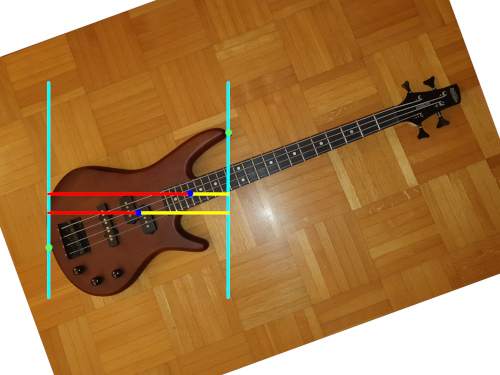You have to make your own fun. Or do what is fun for you. There is no wrong way to play the game. Something along those lines.
So, while waiting for my fingers to tough up, let’s improve on the instrument “at hand” so to say.
One way to improve the “neck dive” (besides a more grippy strap or changing the locations of the strap buttons) is to add some weights to the instrument on the opposite side. The math tells me to add at least 1.5kg of mass to the instrument to balance it middle way between the strap buttons. That is too much. I don’t hate my back that much. But adding some 400g would move the center of gravity a couple of centimeters, just enough to let the strap hold on with the friction.
But this led to a thought: “will this change how the instrument sounds”. You don’t have to play the Wiki Game to find a plethora of opinions on what will change, ruin or improve “the sound”. I am also aware of the concept of the “produces switch”, which works on way more things than just instruments.
So let’s explore this. Python is good for such quick data science science and simulations. Grab a library for sound propagation, simwave worked in this case. True it is for simulating sound propagation for seismic research, so the scale is a bit off, but nothing that can be adjusted. Learn what the density of required wood and metal are. Learn what Okoume wood is and that as cool as bismuth would be cool for a weight, scavenging local crystal shops for it would be a pain, settle on lead. Make an image of the instrument with different colors for density and see what happens. And because we don’t have all the patience in the world, a 2D sim will be fine.
Neat, now let’s do this for some weights. The images are links to videos!
Now, this is far from a proper study, can’t compete with Yamaha and 3D simulation assisted design of chambered bodies.
But something tells me, in the end, no matter what the actual modification will be, it will be fine.
Now here is something new and different.
A new instrument. I have yet to buy an instrument for myself. Mostly on the account of being “kicked out” of music school for not having enough talent in primary school. Well, the desire to push keys transferred to a different kind of keyboard, which instead of noises produced system calls.
Now this is a direct result of visiting the Guitar Museum in Umeå, Sweden. Catching the guided tour by the owner, who went above and beyond to explain and show off the collection (specially since there were only two visitors there and some knowledge of rock and roll history was shown), kick-started this whole “something different” thing. If you have a chance, I cannot recommend it enough.
As you do, after such an experience, you find a music shop for a souvenir or two (beside the t-shirts from the museum itself). Long story short, there was this micro bass, on sale, which being cheaper than some lunches I had in Scandinavia, fall under the category “why not”.
Well, this opened up a convoluted rabbit hole of diving in to bass related music research.
What I got was a lovely Ibanez mikro bass model GSRM20B.
Flailing with the new toy, one potential improvement became obvious. The thing has a bit of a “neck dive”.
If nothing else, I am an engineer, so off to do some calculations.
The math comes to the torque, because of the position of the center of gravity, being about 2.3 times grater towards the front of the bass.
This can be improved.





